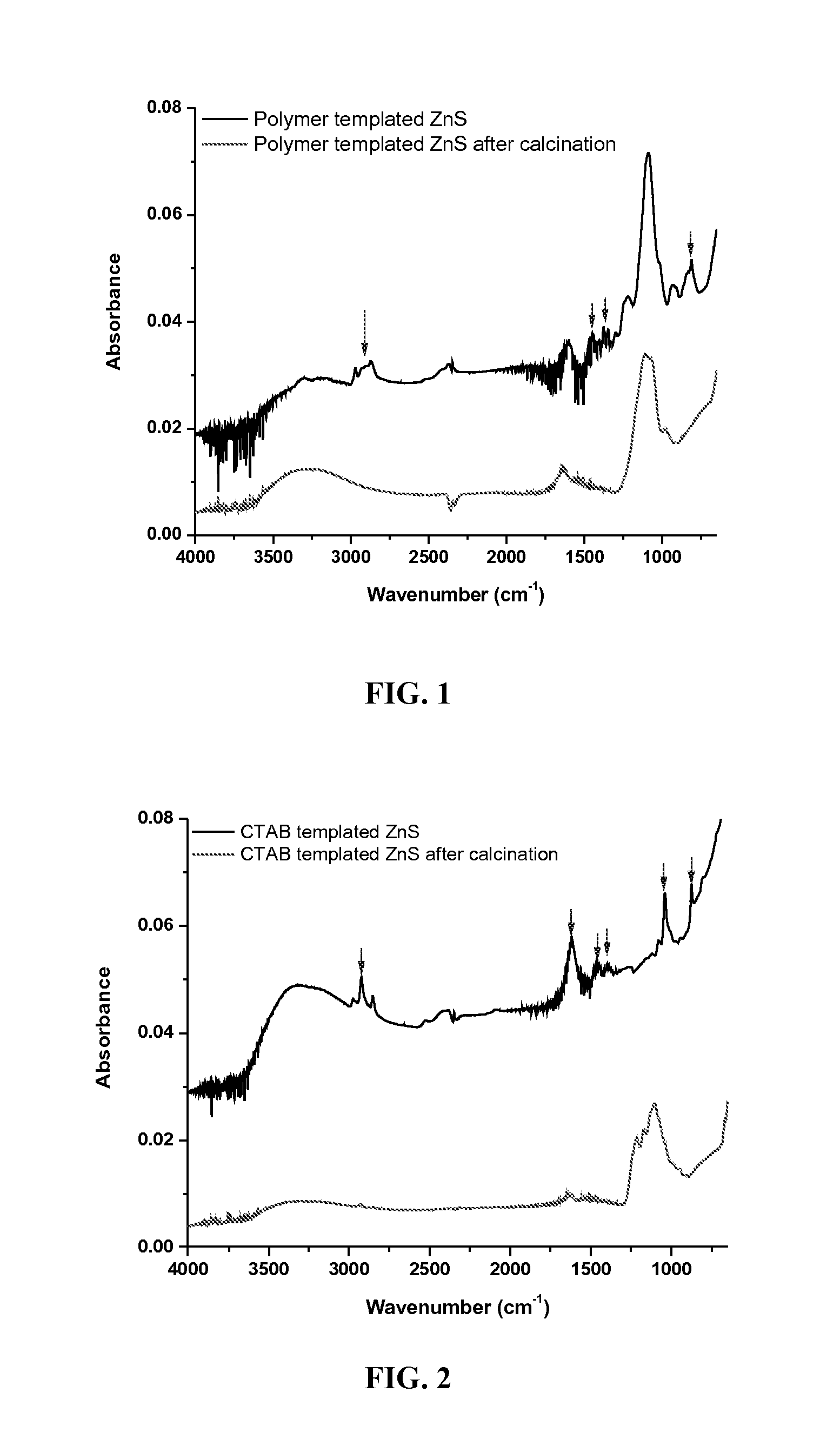Nanocomposite material for direct spectroscopic detection of chemical vapors
a technology of chemical vapor detection and nanocomposite materials, applied in the field of material, detectors and systems for spectroscopic detection, can solve the problems of complex methods, high operator training, and high equipment cost, and achieve the effects of high uptake, high adsorption capacity, and high adsorption capacity
- Summary
- Abstract
- Description
- Claims
- Application Information
AI Technical Summary
Benefits of technology
Problems solved by technology
Method used
Image
Examples
example 1
Synthesis of ZnS Using Cetyl Trimethyl Ammonium Bromide (CTAB) as Template
[0051]Materials templated with cetyl trimethyl ammonium bromide (CTAB) were synthesized by dissolving 3.0 g of zinc chloride and 1.9 g of CTAB in 50 mL water and subsequent addition of 6.0 g of sodium sulfide dissolved in 50 mL water with continuous stirring. The pH of the mixture was then adjusted to 6 by adding 6 M hydrochloric acid, and the mixture was allowed to stand in the fume hood for 4 days, washed with water, refluxed in ethanol for 2 days and dried in a vacuum oven. The yield was determined to be 1.24 g of the CTAB-templated material.
example 2
Synthesis of ZnS Using a Pluronic Copolymer as the Template
[0052]In a manner similar to Example 1, other polymer-templated materials were synthesized by first dissolving 3.0 g of zinc chloride and 3.0 g of PLURONIC 123 copolymer (PLURONIC 123 is a trademark of BASF Corporation in New Jersey, identified as an EO20 / PO70 / EO20 triblock copolymer) in 50 mL of water. To this solution were added 6.0 g of sodium sulfide dissolved in 50 mL of water under continuous stirring. The pH was adjusted to 6 by adding 6 M hydrochloric acid, and the resulting mixture was allowed to stand in fume hood for 4 days. The crude product was rinsed with water and ethanol, as described above, and dried in a vacuum oven. The yield was determined to be 1.6 g of the copolymer-templated material.
example 3
Template Removal
[0053]The material samples obtained in Examples 1 and 2 were each placed in a ceramic crucible and calcined in a muffle furnace at 400° C. in air for 1-3 days. The calcined materials were then suspended in 0.01 M hydrochloric acid and agitated for 15-20 minutes. The solids were collected by centrifugation, washed with deionized water and methanol, and finally dried in a vacuum.
[0054]Calcination at moderately high (400-600° C.) temperatures was used to quantitatively remove organic matter, because the absence of organic residues is expected to improve both the optical transparency in the mid-IR range and the amount of gold nanoparticles that can be adsorbed onto the surface. However, since metal sulfides are susceptible to oxidation, the calcination temperature was carefully adjusted to about 400° C. This temperature was sufficient to completely eliminate organic residues while preventing the zinc sulfide from being oxidized. Calcination and characterization were perf...
PUM
 Login to View More
Login to View More Abstract
Description
Claims
Application Information
 Login to View More
Login to View More - R&D
- Intellectual Property
- Life Sciences
- Materials
- Tech Scout
- Unparalleled Data Quality
- Higher Quality Content
- 60% Fewer Hallucinations
Browse by: Latest US Patents, China's latest patents, Technical Efficacy Thesaurus, Application Domain, Technology Topic, Popular Technical Reports.
© 2025 PatSnap. All rights reserved.Legal|Privacy policy|Modern Slavery Act Transparency Statement|Sitemap|About US| Contact US: help@patsnap.com



